What do you do when a meteor swarm threatens Earth with destruction? You launch a bunch of rockets, of course! But you better be quick, because you’ve only got about five minutes before impact. Meteor is a real-time cooperative game from Mayday Games that’s very challenging and very quick to play.
At a glance: Meteor! is for 1-5 players, ages 13 and up, and plays in 5 minutes or less. The age rating can be flexible, since there’s nothing particularly graphic or inappropriate about the game. The tricky part is deciding whether your kids can keep up with the rules of the game and figure out the strategy, because even working together it’s hard to win. The pledge level for a copy of the game is $35 on Kickstarter.
New to Kickstarter? Read our crowdfunding primer.
Components
Here’s the components image from the Kickstarter page:
The game includes:
- 5 sand timers
- 5 Altitude Zone cards
- 39 Energy cards
- 31 Rocket cards
- 26 Meteor cards
- 10 Boss Meteor cards
- 6 Technology cards
- 11 Challenge cards
- 13 Power cards
- and a few other reference cards
I played with a demo prototype so my cards are not final quality, but from what I can see on the Kickstarter page the majority of the cards look about the same. The illustrations are a simple, cartoony style; the overall design feels a little less polished to me.
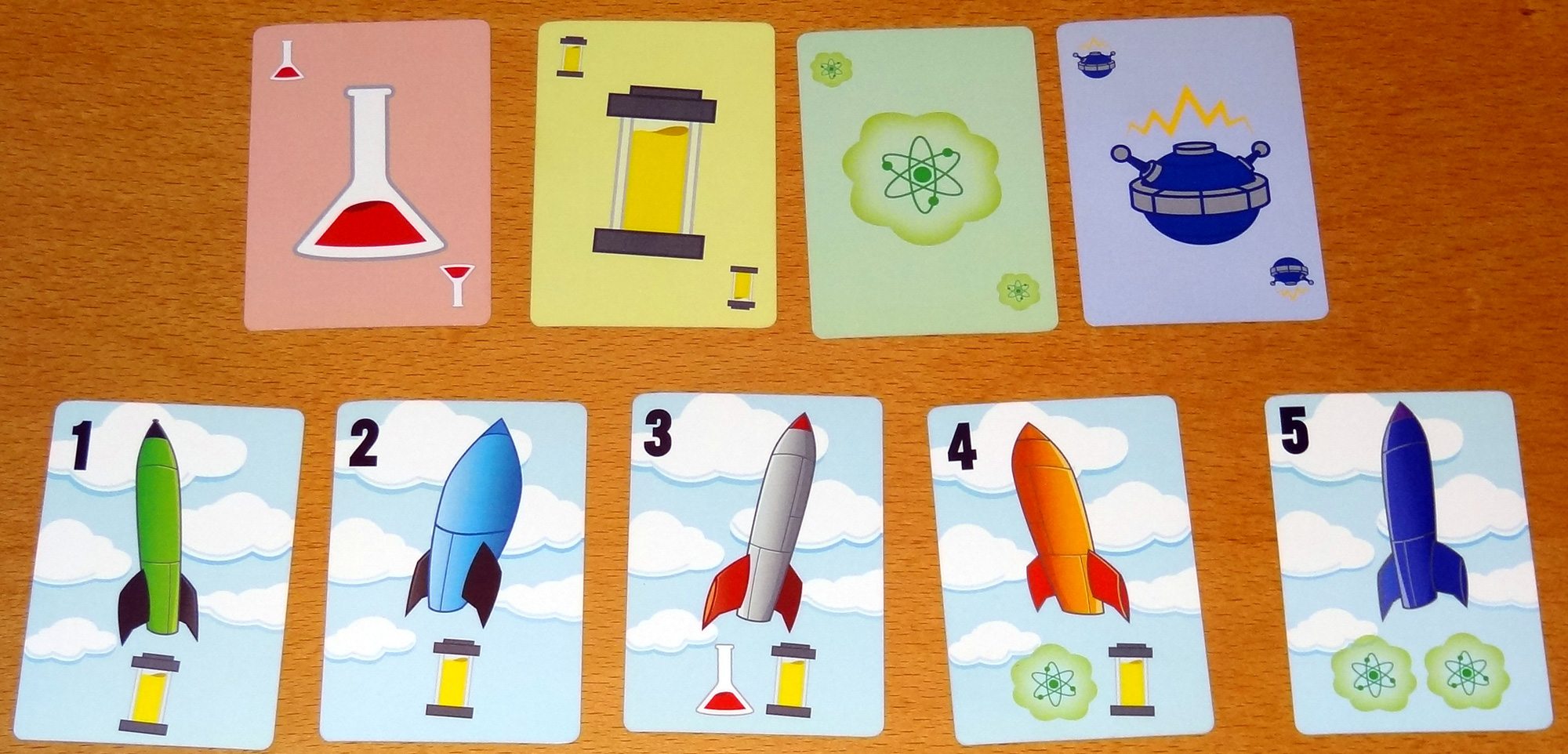
The rockets and energy cards are really easy to understand at a glance: each rocket has a number that shows its strength, and some number of icons below it. The energy cards each depict just the icons, and you match up energy cards to the rockets to power them up.
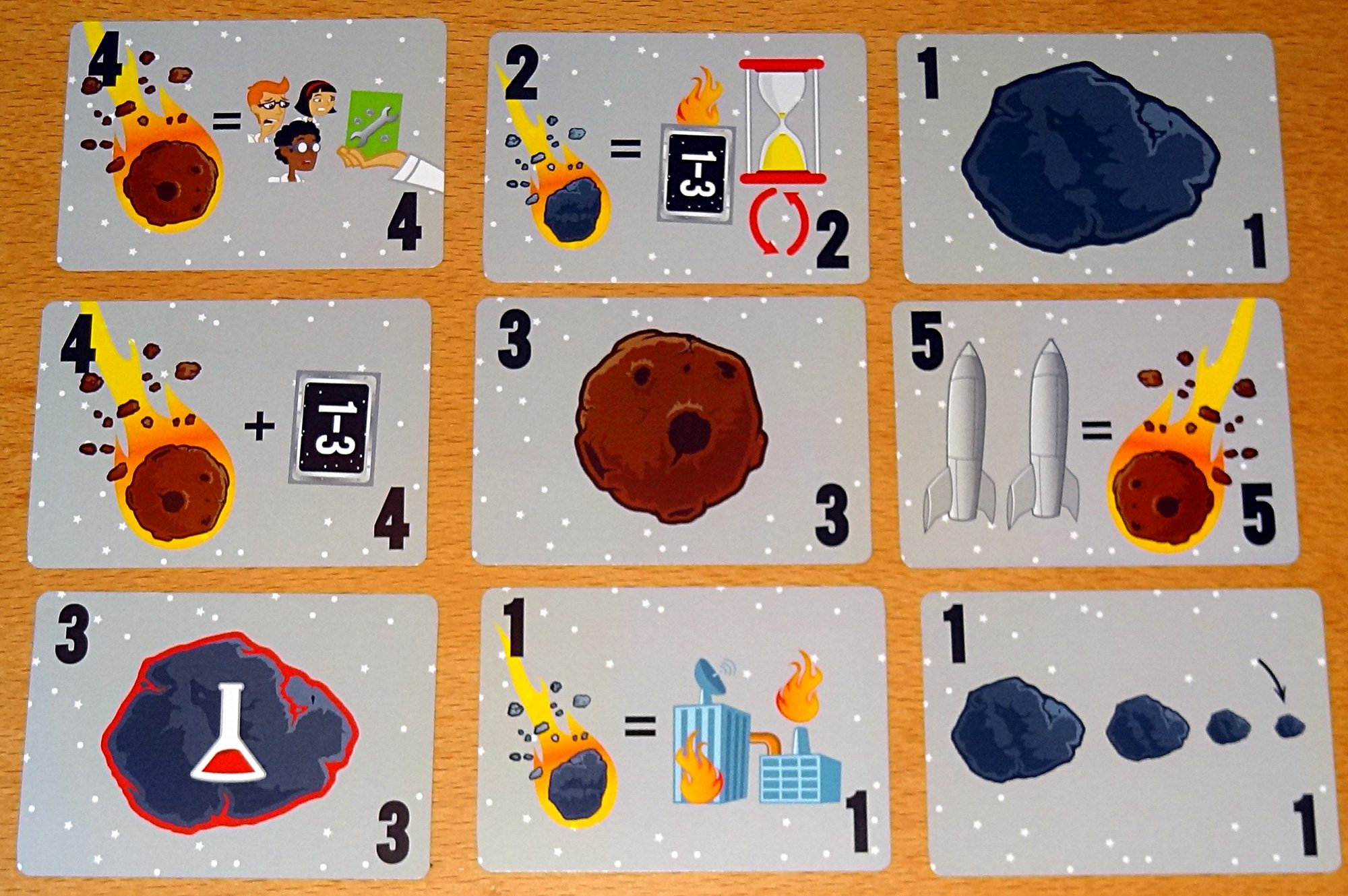
The technology cards and meteor cards can get a little more confusing. Meteor cards have a range on the backs (“1-3” or “3-5”) and then a power on the front. But some meteors also have special rules: fast meteors must be destroyed before they reach altitude 1; radioactive meteors explode and destroy other meteors; splitter meteors add additional meteors to the table when you destroy them. Some of the icons are easily deciphered, but there are so many types of meteors that you may have to refer to the rulebook the first few times you play—which is tricky to do in the middle of a 5-minute real-time game.

Technology cards also have energy requirements at the bottom (like rockets) and can be built for effects. Some are pretty self-explanatory, but others are confusing. I applaud Mayday Games for trying to make the game language-independent, but I just think the iconography isn’t very intuitive.
There are also Boss Meteors and Challenge cards to make things harder, and Power cards to make things a little easier.
Finally, the retrofit reference cards are just a bit silly. Basically you can do a retrofit for four rockets or four energy cards—they have to be all the same, or all different. For some reason this necessitated a two-sided reference card that depicts all the possible ways to make a four-card combination.
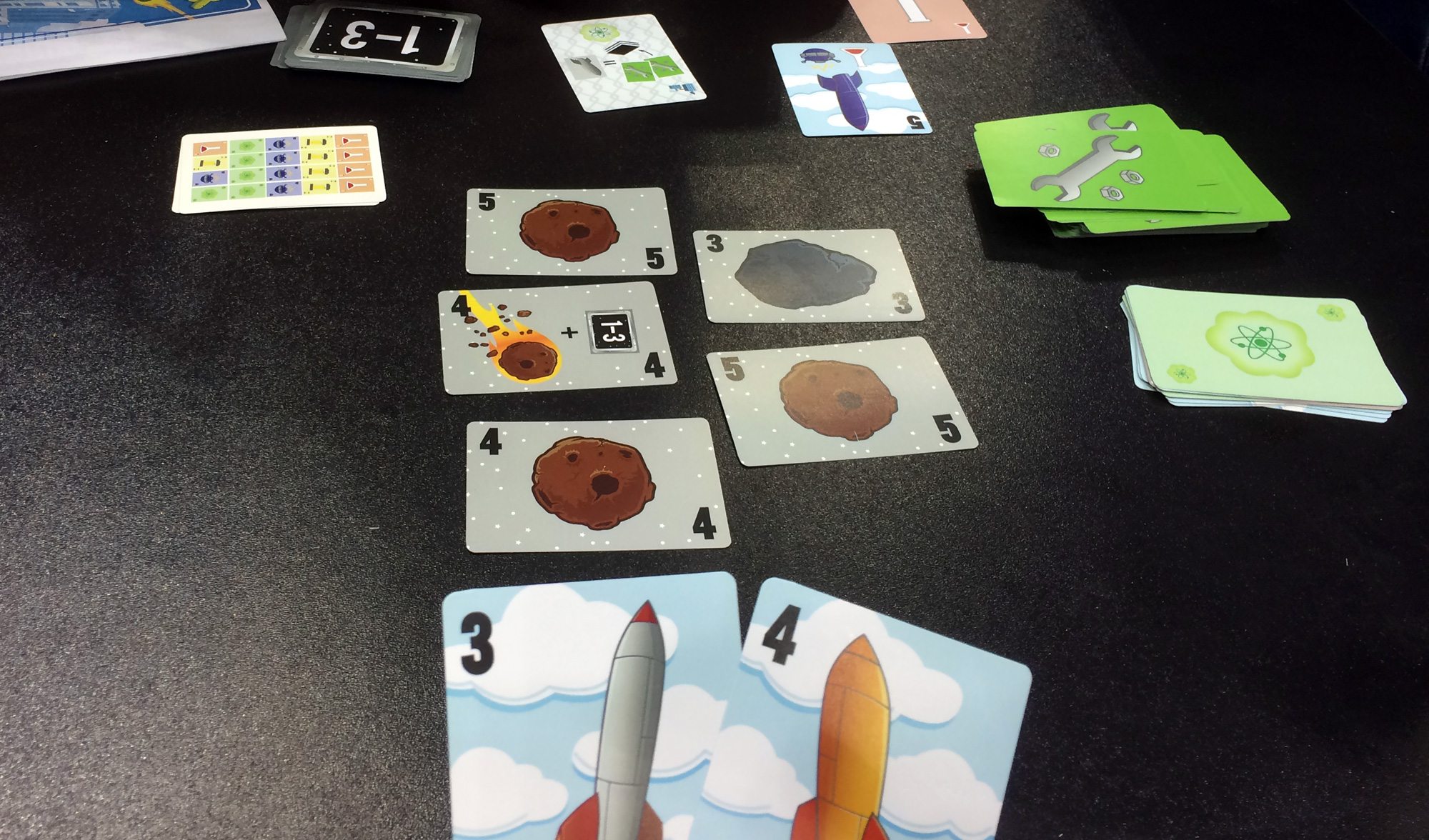
How to play
The rulebook is available here as a PDF.
The goal of the game is to shoot down all the meteors before they hit Earth (in 5 minutes or less).
You’ll start by placing a number of random meteors on the table (based on number of players) and deal everyone a hand of cards (the more players there are, the fewer cards each player gets). The 5 Altitude Zone cards are placed in order with 5 on top, and the sand timers are readied.
When the game starts, one timer is flipped and then play is simultaneous. If the sand runs out, or if all players agree that there are no more possible moves and pass, then you flip to the next Altitude Zone and flip another sand timer—and then everyone gets to draw a card. If the time runs out on Altitude Zone 1 and you haven’t destroyed all the meteors, then you lose.
Every player has a launch site: you may build either a rocket, technology, or a retrofit, and you may discard what you’re currently working on to build something else at any time. You may play cards in another player’s launch site, as long as that player has at least one card in it already. Only one thing can be built at a time.
Rockets and technologies are built by playing matching energy cards. As soon as enough energy cards are played, a rocket may be launched, but you may also wait to combine it with rockets from another player. Technology cards are moved to the center and are immediately active when built.
A retrofit is a way to get more cards: to complete a retrofit, you’ll need either four rockets or four energy cards, and they must be all the same or all different. Once built, these cards are discarded, and the team gets to draw five new cards from the deck.
When a rocket is built, you may launch it and pick a meteor to shoot. If it hasn’t been revealed yet, you flip it over to find out what the strength is. If the rocket’s power is lower, the meteor is unharmed. If it’s equal or higher, the meteor is destroyed—but if you overkill by launching a rocket that is more powerful than the meteor, it blasts all the other meteors closer to Earth, and you drop an altitude level.
Oh, and one more rule that makes everything even more challenging: no talking. Yep, you read that right. You’re basically playing this without being able to say anything, so you’re relying on charades and raised eyebrows. There’s a “communications satellite” technology card that allows you to start talking once it’s built, but without it you’ll find that it’s pretty crazy.
That’s basically it. You play until all of the meteors are destroyed, or until the time runs out in Altitude Zone 1.
The Verdict
I played a demo of Meteor at Gen Con this year, and it was a lot of fun. We tried it first without the “no talking” rule in place and with all the meteors revealed from the start, and it was challenging but we survived. When you hide the meteors, it gets a lot harder—you run the risk of wasting precious cards by launching rockets that are too weak, or else you might cause overkills that use up time on the clock. And then you take away the ability to talk out strategy, and it gets insane.
All of that in five minutes or less.
The most problematic thing about cooperative games is the alpha player syndrome—that is, one player takes over and starts instructing everyone else, turning it into a game of solitaire. It doesn’t happen with every gaming group, but it’s fairly common, particularly if one player knows the game better than everyone else. There’s a fine line between “let me teach you the rules” and “watch me play this game.”
The ways that game designers have tried to get around the alpha player often involve time limits (so there’s not enough time for one player to micromanage everyone) or limited information (I can’t tell you what to do if I don’t know what’s in your hand). Meteor uses a combination of both: the five-minute limit definitely keeps the pressure on so that you need to act quickly, and the no-talking rule means that you just have to play cards and see if other players pick up on your hints.
I wasn’t sure how I felt about the idea of a no-talking rule, but it turns out that since it’s such a short game, it adds interesting tension without making you feel like you’ve been forced to take a vow of silence. However, it is really hard when you can’t talk. I haven’t even started using things like Boss Meteors and Challenge cards because just playing with the standard rules is hard enough.
Real-time cooperative games aren’t for everyone, but I’m a fan, and Meteor is a nice, fast-paced game that I’ve found myself playing several rounds in a row. My only real complaint is the graphics on the more complicated cards (see the “Components” section above), because it takes time to learn what all the icons mean, and when you’re making real-time decisions, 10 seconds to argue about a card’s meaning is too long.
I wouldn’t say that Meteor is my favorite cooperative game, but it’s certainly one of the fastest, and will make for quick fix when I’m looking for a real-time game or a cooperative game.
The Kickstarter campaign for Meteor launched last week and the game is already funded—planned stretch goals will improve the quality of the components and add some more cards to the game. MayDay Games has had a pretty good track record so far of delivering their Kickstarter games (though a few recent ones are delayed), and I don’t foresee this one being a difficult one for them to produce, since it’s just cards and a few sand timers.
For more information about Meteor, visit the Kickstarter page.
Disclosure: GeekDad received a demo prototype of this game for review.
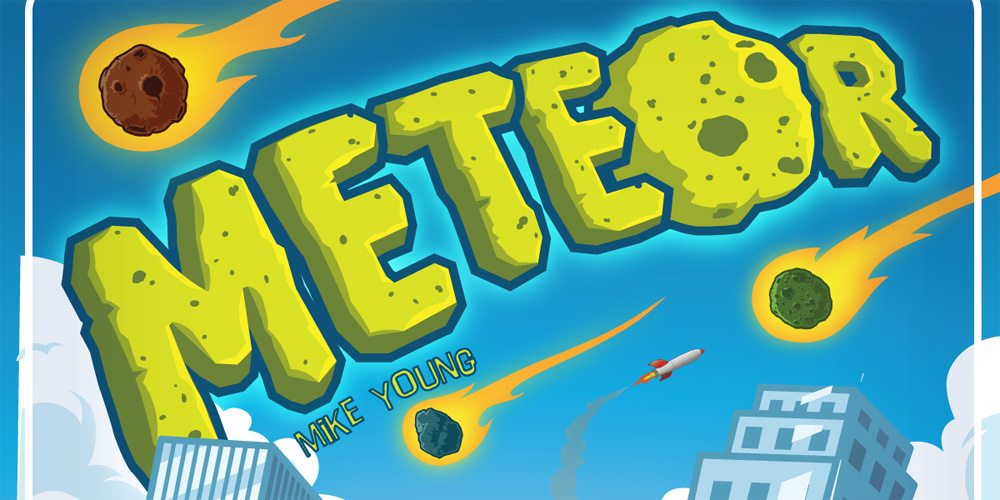
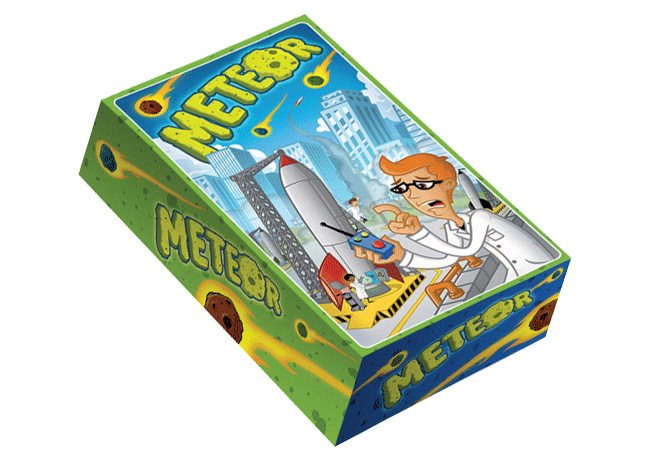





I had been cutting back, but couldn’t resist this one. Looks like a fun, quick game to play with the kids.
FYI – They are including a free game if you backed one of their other project (like Dead Man’s Draw)
https://www.kickstarter.com/projects/maydaygames/dead-mans-draw-pirate-themed-press-your-luck-card/posts/1008578
Well, I’ll apologize in advance, John, because October looks like another month of board game Kickstarterpalooza. There are at least 7 other games I’ve been trying out that have just launched or will be launching later this month.
Hopefully I get my money back from the Ice Age Mammals fiasco and maybe I can partake in the palooza-ing!
Right now, besides Meteor, I’m backing Upworks, King Down, and Twisting Catacombs, both with low pledges. I’ve had so many projects deliver in the last 6 weeks that it’s easier to pass up on some of the new projects. But the September lull has made it easy.
Yes, there are a lot that I haven’t backed at a full level because there are just so many, but I try to follow the updates at least, so that when the game is finished and in stores I’ll remember to look for them then.